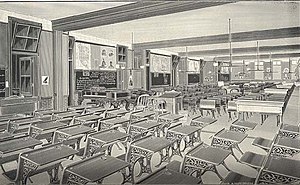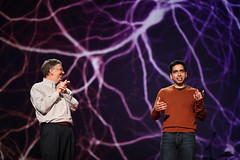 Image via Wikipedia
Image via Wikipedia
Dear Mr. President,
Now that you have caught the world's most wanted man, what's next? You've proven yourself as someone who is not afraid to tackle tough issues and insurmountable tasks, so may I suggest education? I can imagine the look on your face right now. Although education is a popular cornerstone in politics, getting two people to agree on what should be done is about as popular as ... well, healthcare. I'm sure you have many gray hairs to blame on that battle, but don't despair.
Let me remind you of what you said in Cairo on June 4, 2009:
"I know there are many – Muslim and non-Muslim – who question whether we can forge this new beginning. Some are eager to stoke the flames of division, and to stand in the way of progress. Some suggest that it isn't worth the effort – that we are fated to disagree, and civilizations are doomed to clash. Many more are simply skeptical that real change can occur. There is so much fear, so much mistrust. But if we choose to be bound by the past, we will never move forward. And I want to particularly say this to young people of every faith, in every country – you, more than anyone, have the ability to remake this world."
That went over pretty well didn't it? From Tunisia to Syria, people are rising up in popular protests and, although it may be premature to judge how this will turn out, I think most feel it is a good thing. A number of countries are shedding dictatorships and hoping for an equal distribution of wealth and opportunity. So let's start another revolution---one in this country that affects us all. Let's talk about public education.
As I see it, there are three points of view in this debate: politicians, school administrators, and teachers. All three purport to have the students' best interests in mind. The main difference is that the first two depend on statistics to make their points and the last has actual contact with the students. I'm not against the use of statistics in making policy decisions, but here's the problem: statistics require data, and data needs to be something you can quantify or measure. This brings us to a sheet of paper with an array of bubbles marked A, B, C, & D. As most teachers can tell you, standardized testing is a convenient way to give a test, but the results only give you a glimpse of a child's mind. Most of these tests measure the lowest levels of thinking: recall, comprehension, and application. It isn't easy to formulate an assessment that measures critical thinking, problem solving, and innovative use of knowledge; attributes you have valued in
your education plan. Clearly, something was wrong when test taking skills became the priority for school districts and parents, rather than the students' intellectual growth, and so I am glad to read your recent comments on this.
In March, you urged Congress to come up with a
new plan for education. It seems the
No Child Left Behind plan of your predecessor isn't quite working out as it was thought it would. According to the Huffington Post, " The Education Department estimated last week that the percentage of schools labeled as 'failing' under the law could more than double this year, jumping from 37 percent to 82 percent as states boost standards to try to satisfy the law's mandates." You said, "In the 21st century, it's not enough to leave no child behind. We need to help every child get ahead. We need to get every child on a path to academic excellence." I don't mean to put any more pressure on you, but you have to know that it starts at the top and works its way down. Administrators will do what the politicians tell them, the teachers will do what the administrators tell them, and the students will do what the teachers tell them. Why is it that teachers seem to be the focal point on whether or not these plans are successful? Yes, there are some bad teachers just as there are bad doctors or bad brick layers; all should be held accountable. But a growing sentiment among teachers is '
don't blame the soldiers for losing the war.'
No one becomes a teacher because it's a glamorous job. It isn't high paying and for those who are quick to point out the summers off as a luxury, let me ask you this: How many occupations require a person to work a full day's work, and then to go home and work several more hours each night? I don't see airline pilots taking a 747 home with them, or a nurse with a car full of patients. How many occupations necessitate that hours of work are done every weekend? I'm sure there are some, lawyers working on briefs, or accountants balancing numbers in their after hours, but how does their pay compare to that of a teacher? Teachers aren't only grading papers, but planning, creating, and researching for their work as well. Beyond the children they are in charge of, they also coordinate with their peers, administrators, and parents. A teacher's day doesn't end with the final bell. I'm not against year-round schooling or extending the school day, but I am keenly aware of time dedicated teachers put in outside of the classroom.
So where should you start? If you truly want 21st century learning, then take a hard look at the 20th century approaches we cling to. There is enough course material to fill any textbook or standardized test at any grade level many times over. This coverage is referred to as "a mile wide and an inch deep." So what is the absolute knowledge required for today? Is it the same as the previous century? This is a formidable examination to pursue, but one that is decades overdue.
Next, ask yourself how much weight do you want to give this content knowledge. Do you think it is more important that students are knowledgeable, or that they know how to find the information they need and how to use it? Remember those bubble tests; what are they measuring? Content knowledge is important, but not as much as it used to be. My smart phone can provide me with the answers to a million questions. Even still, I think it was Jefferson's mind rather than his library that made him a great thinker.
The next aspect to examine is whether there is a model of education that is flexible enough to meet each student's needs. For a long time it was 'one size fits all', It isn't easy to adapt lessons or assessments for every individual. Not impossible, but not easy. Your course material and testing needs to be fluid if you truly want to meet each students' needs. The good news here is that technology will enable us to to accommodate, challenge, and assess a wider range of students more easily.
These are just some of the tenets that need to be addressed. I don't mean to discourage you, but education reform is much more complicated than the revision of health care. As usual, there will be a chorus of dissenting voices, but I feel politicians need to understand that true change isn't going to occur just by raising test standards. This isn't an issue that lasts one news cycle or a 6 month re-election period. You need to filter out that noise and listen to the people whose passion is education year after year. I've found the most progressive minds in education today are those educators involved with technology. They are innovative. They are problem solvers. They are what you want the students of tomorrow to be. I am encouraged by what I've been hearing lately on the
DOE's efforts. I wish you luck and will support your efforts for true reform in education.
Test Problems: Seven Reasons Why Standardized Tests Are Not Working
National Education Technology Plan 2010





































